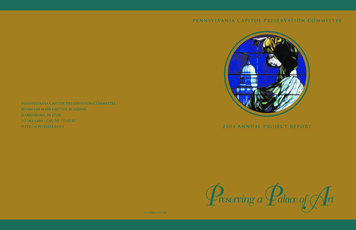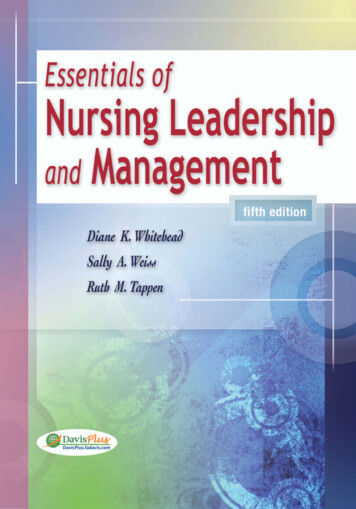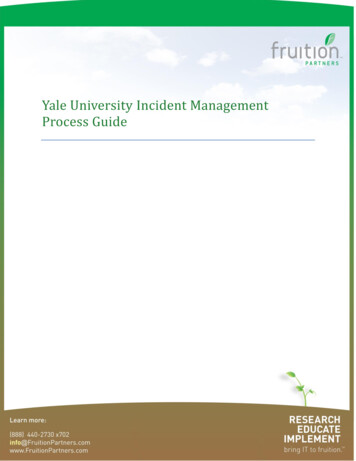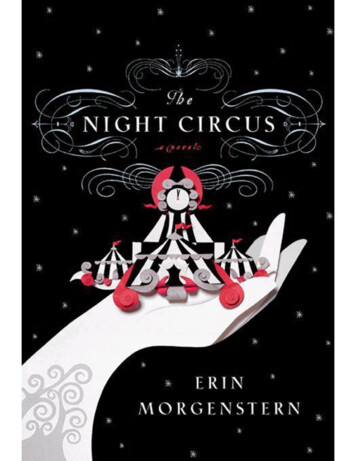
Transcription
P E N N S Y LVA N I A C A P I T O L P R E S E R VAT I O N C O M M I T T E EPennsylvania Capitol Preservation CommitteeRoom 630 Main Capitol BuildingHarrisburg, PA 17120717-783-6484 Fax: 717-772-07422004 ANNU AL PR OJECT REPO RThttp://cpc.state.pa.us 1/2005 CPC-017Preserving aPalace ofArt
TABLEOFC ONTENTSIntroduction . . . . . . . . . . . . . . . . . . . . . . . . . . . . . . . . . . . . . . . . . . . . . . . . . . . . . . . . . . . . . . . . . . . . . . 1“ARCHITECTURE” BY WILLIAM BRANTLEY VAN INGENFeatured Capitol Artists. . . . . . . . . . . . . . . . . . . . . . . . . . . . . . . . . . . . . . . . . . . . . . . . . . . . . . . . . . 2Chairman’s Message and Committee Member Listing . . . . . . . . . . . . . . . . . . . . . . . . . 6Committee Projects . . . . . . . . . . . . . . . . . . . . . . . . . . . . . . . . . . . . . . . . . . . . . . . . . . . . . . . . . . . . . . . 8Historic Timeline—On This Day In History. . . . . . . . . . . . . . . . . . . . . . . . . . . . . . . . . . . . 11Pennsylvania’s Civil War Treasures . . . . . . . . . . . . . . . . . . . . . . . . . . . . . . . . . . . . . . . . . . . . . 16rotunda Exhibition: “Capitol Artists”. . . . . . . . . . . . . . . . . . . . . . . . . . . . . . . . . . . . . . . . . 24History Under Foot—The Capitol’s Moravian Tile Pavement. . . . . . . . . . . . . . . 30special events and awards . . . . . . . . . . . . . . . . . . . . . . . . . . . . . . . . . . . . . . . . . . . . . . . . . . . . . . 32preserving pennsylvania’s rare books . . . . . . . . . . . . . . . . . . . . . . . . . . . . . . . . . . . . . . . . . 36Lost and Found. . . . . . . . . . . . . . . . . . . . . . . . . . . . . . . . . . . . . . . . . . . . . . . . . . . . . . . . . . . . . . . . . . . 38The Pennsylvania Capitol Preservation Committeeproudly pr esents the four th in our special series of annualproject reports leading up to the 2006 celebration of theCapitol’s 100th Anniversary.An enor mous amount of talent went into creating theartwork that adorns the Pennsylvania State Capitol. OurGifts and Collectibles. . . . . . . . . . . . . . . . . . . . . . . . . . . . . . . . . . . . . . . . . . . . . . . . . . . . . . . . . . . 422004 report pays tribute to five of the Capitol artists—eachMission Statement. . . . . . . . . . . . . . . . . . . . . . . . . . . . . . . . . . . . . . . . . . . . . . . . . . . . . . . . . . . . . . . . 46of whom in his or her own way contributed to the beauty of theGifts and Collectibles Order Form. . . . . . . . . . . . . . . . . . . . . . . . . . . . . . . . . . . . . . . . . . . . 47Photography Credits. . . . . . . . . . . . . . . . . . . . . . . . . . . . . . . . . . . . . . . . . . . . . . . . . . . . . . . . . . . . 48Capitol, and the great history of our Commonwealth.1
EFEATURED Cdwin Austin Abbey was one of themost celebrated artists of his day .Born in Philadelphia, he brieflystudied at the PennsylvaniaAcademy of theFine Arts underChristianSchuessele.Before he wastwenty yearsold, Abbeyenjoyed abrilliant careeras an illustratorof poetry anddrama for Harper’sWeekly. In the late1870s Abbey leftfor England topursue a career asa lar ge-scale histor ypainter. While therehe was elected to theRoyal Academy andadmitted to the eliteartistic circle of thePre-Raphaelites.As a r esult of his gr owing r eputation,Abbey was invited by American sculptorAuguste Saint-Gaudens in 1890 to produce whatwould become his most famous commission, themural cycle “The Quest for the Holy Grail,” forthe McKim, Mead, and White Boston PublicLibrary, which was completed in 1901.In 1902 Abbey received his largestcommission—decorating the r otunda andHouse, Senate, and Supreme Court Chambersin the Pennsylvania Capitol. He executed the2Capitol murals at his studio in England. Byspring 1908 Abbey completed the rotundamurals, which were exhibited at theUniversity of London. They received thehighest acclaim as King Edward VII himselfexpressed regret that these magnificentpaintings were leaving England. In 1909the rotunda murals were shipped toHarrisburg and placedat the collar of theinterior dome.WhenAbbey diedsuddenlyin 1911, hiswidow administered thecompletion andinstallationof the HouseChamber murals.The artist hadcompleted threeworks; a fourthhad been partiallycomplete and wasfinished by Er nestBoard, a member ofAbbey’s studio, under the supervision of JohnSinger Sargent. Only one mural had beenexecuted for the Senate Chamber entitled,“The Camp of the American Army at V alleyForge, Febr uary 1778.” Completed in 1910,this painting had originally been placed in theSenate Chamber . As a result of Abbey’suntimely death, it was r emoved and hung onthe north wall in the rear of the HouseChamber where it remains today.A P I T O LGARTISTSeorge Grey Bar nard was asculptor hailed as theMichelangelo of his time. Bornin Bellefonte, Pennsylvania, hisfamily moved to the Midwest where from ayoung age Barnard was interested in creatingform with his hands. At age nineteen, Barnardenrolled in the Chicago Art Institute andencountered the works of the Renaissancemaster Michelangelo, who henceforth becamehis idol and source of inspiration.Within a year , Barnard had sold aportrait bust of a child for 300, and set off forParis to advance his artistic training. Hestudied four years at the Ecole des BeauxArts. At the Ecole, he lived in impoverishedconditions as a recluse totally obsessed withhis sculpting—a fur ther analogy to hisRenaissance counterpart.Barnard’s first patron was AlfredCorning Clark of Singer ManufacturingCompany fame. Clark commissioned severalmonumental sculptur es until his death in1896. After experiencing financial dif ficulties,it wasn’t until 1902 that Bar nard’s career wasrevived with the commission for the sculpturalgroups at the Pennsylvania Capitol.Barnard acquired a love of artfrom the Middle Ages during hisyears in France spent working onthe Capitol gr oups. Hespent much of hisspare time collectingmedieval sculptur e. In fact, hewas able to pay for some of the supplies neededto complete the Capitol sculptures by sellingantiques to wealthy patrons in the states.Barnard’s years of collecting eventually resultedin the building of The Cloisters, which waslater purchased by John D. Rockefeller anddonated to the Metropolitan Museum of Art.The Capitol groups were finished in1910, shipped from France to Harrisburg forinstallation, and officially unveiled onOctober 4, 1911. They represent a significantcomponent of his artistic evolution. Barnardsaid “in that plan I had concentrated a lifeof study and thought.” At his request, GeorgeGrey Barnardwas buried inHarrisburg tobe near to whathe consideredhis finest work.3
Henry Chapman Mercerwas born in Doylestown,Pennsylvaniaand attended HarvardUniversity and the University ofPennsylvania Law School.Although he was admittedto the Philadelphia bar ,Mercer never practicedlaw but turned his intereststowards a career inpre-historic archaeology.From 1894 to 1897,Mercer was Curator ofAmerican and Pre-historicArchaeology at TheUniversity of PennsylvaniaMuseum, Philadelphia. Aturning point in his life camein 1897 upon seeing a jumbleof old agricultural tools andhousehold utensils for sale.Mercer realized how quicklyAmerican pre-industrialhistory was being destroyedby the modernization ofthe world. He began to“rummage the bake-ovens,wagon-houses, cellars, haylofts,smoke houses, chimney-corners, andgarrets” for what historians would latercall “Americana.”Mercer collected all kinds of Americanartifacts and tools from hoes and forks to plowsand potter y. In 1913 he began work on amuseum to house his growing collection of morethan 25,000 objects. Today there are over 40,000tools of more than sixty early American craftsand trades displayed in the Mercer Museum.As part of his collecting, Mercer becameinterested in the pottery of PennsylvaniaGermans. Concer ned that this craft was dyingout, Mercer apprenticed himself to one of thefew authentic potters in upper Bucks4County to learn all about clays, glazes, andkilns. In 1899 Mercer built the MoravianPottery and T ile Works, which still operates inDoylestown today.By 1900 Mercer had become an importantfigure in the Arts and Crafts movementin America. In 1903 he received his largestcommission—tiling the first floor of thePennsylvania Capitol. The approximately 16,000square feet of tiles include nearly 400 mosaicsthat run chronologically from Indian activitiesand artifacts to more modern devices likeautomobiles and the telephone. Interspersedthroughout these figurative inlays are mosaicsrepresenting Pennsylvania’ s native floraand fauna.Violet Oakley knewfrom an early agethat she wanted tobe an artist. Shedeveloped her talent by studyingat the Art Students League inPhiladelphia and variousinstitutions abr oad duringher summer vacations. Muchof her talent wasfostered through selfdirected lear ningby studying andcopying the oldmasters.Oakley’s familymoved to Philadelphia in1896 where she enteredHoward Pyle’ s illustra tion class at DrexelInstitute. Sheflourished under Pyle’stutelage and soonbecame one ofAmerica’s most popularillustrators, designingcovers for Century Magazine ,Collier’s Illustrated W eekly, Everybody’s M agazine,St. N icholas , and Woman’s Home Companion .Oakley also gained reputation as a talentedstained glass designer.In 1902 Pennsylvania Capitol architectJoseph Huston asked Oakley to paint thirteenmurals for the Governor’ s Reception Room.Huston believed that choosing Oakley would“act as an encouragement of women and theState.” Oakley’ s commission signified amilestone in American art history as the largestpublic commission given to a woman up to thattime. It also allowed her to transcend theconventional female roles of portrait and genrepainters, and to pursue a successful career in theprestigious, but overwhelmingly masculine fieldof mural decoration.Oakley received much publicity throughout her work on the Governor’s ReceptionRoom. The murals won her the Gold Medal ofHonor from the Pennsylvania Academy of theFine Arts in 1905, making her the first woman toreceive this distinction.After Edwin Austin Abbey’ s death in1911, Oakley r eceived the commission to complete the contract for the Senate and Supr emeCourt Chambers. She painted a total of fortythree murals for the Pennsylvania Capitol.William Brantley V an Ingenwas born in Philadelphia andstudied at the PennsylvaniaAcademy of the Fine Arts as apupil of Thomas Eakins and ChristianSchuessele. After completing his studies at theAcademy, he moved to N ew Y ork wher e heapprenticed under three noted stained glassartists: John La Far ge, Francis Lathr op, andLewis C. Tiffany.Van Ingen was also a noted and prolificmuralist. He was best known in ar tistic cir clesfor his commission by the U.S. Government topaint five murals in the Panama CanalAdministration Building. He also receivedcommissions to paint murals in the Library ofCongress in W ashington, D.C., N ew JerseyState Capitol, U.S. Mint in Philadelphia, andfederal buildings in Chicago and Indianapolis.Van Ingen was awarded the PennsylvaniaState Capitol commission in 1902, and chose torepresent Pennsylvania’s religious developmentthrough fourteen painted murals that reside inthe lunette spaces of the Capitol’ s first floorsouth corridor . He also designed the twentyfour circular opalescent stained glass windowslocated in the House and Senate Chambers,which symbolize Pennsylvania’ s history , art,science, and industry.After receiving a commission fromfinancier, Charles T. Yerkes to make a Japaneseroom for his N ew Y ork residence, V an Ingenvisited Japan and made extensive studies inJapanese art. He also painted murals for privateresidences in Philadelphia.During 1937-1938, under a Depressionera grant fr om the federal government’ s WorksProgress Administration, V an Ingen createdmore than 4,500 square feet of murals for theUniversity at Albany in Hawley Hall.Although best knownfor his ar tistic accomplishments, V an Ingenwas also a strongadvocate of pr eservingN ew Y ork’s publicparklands. He lecturedand wrote on thetopic and ser vedas chairmanof the parkscommittee ofthe N ew Y orkGrand Jur orsAssociation.5
COMMITTEE MEMBERSC HAIRMAN ’S M ESSAGEIt has been another exciting, successful, and productive year for theCapitol Preservation Committee. W e wer e sorry to lose Commi tteemembers, Senator Hal Mowery and John Wesley, both of whomretired, but fortunate to gain member Barbara Franco, Executive Directorof the Historical and Museum Commission.We undertook several large pr ojects throughout the year inconjunction with the Department of General Services, such as therestoration work on the basement areas of the Capitol, including theinstallation of terrazzo floors and replication of the historic lightfixtures. We also placed four original Mercer tile mosaics along with fieldtile back in the original Treasury Room floor.CHAIRMAN PAUL I. CLYMER,REPRESENTATIVEThe yearly conservation maintenance of the Barnard Statues,Hartranft, and Mexican War monuments was undertaken, helping to ensure that these precious outdoorsculptures will survive our sometimes harsh Pennsylvania winters.We also finished the conservation work on the Senate first floor areas and the South Entresol andthird floor level, and began the North Light Court restoration project, one of the last major public spacesthat was pending the completion of the sur rounding floors. The Committee also completed r estorationin the North Office Building’s Senate Hearing Rooms.In addition, we opened an exciting new exhibit in the main r otunda focusing on the major ar tistsof the Capitol—Barnard, Abbey, Oakley, Mercer, and Van Ingen—and their amazing artwork that theyleft for all Pennsylvanians. Next year’s exhibit, set to start in March 2005, will catalog the life’ s work ofCapitol artist Edwin Austin Abbey.We held several special events and exhibits, such as a commemoration of the 100th anniversary ofthe Capitol Cornerstone Ceremony including an exhibit of the cornerstone contents. In October , weexhibited some of the state’s collection of rare books during the course of Pennsylvania Archives W eek,to showcase this invaluable collection that is desperately in need of conservation and a more suitablefacility. These are just a few highlights of the Committee’ s ongoing conservation and maintenance workwithin the Capitol Complex.As we move closer to October 4, 2006, the 100th anniversary of the Capitol’s dedication, wewelcome you to come see what is often termed one of the most beautiful state capitol buildings inAmerica. The Committee members and staf f are proud to serve as custodians for your State Capitol—Pennsylvania’s “Palace of Art.”6Vice ChairmanJohn R. Bowie,Governor’s AppointeeSecretaryThomas B. Darr,Supreme Court AppointeeTreasurerDavid G. Argall,RepresentativeLouis J. Appell, Jr.,Governor’s AppointeeGibson E. Armstrong,SenatorFred Belardi,RepresentativeDonald T. Cunningtham, Jr.,Secretary, Department ofGeneral ServicesBarbara Franco,Beatrice Garvan,Governor’s AppointeeHarold F. Mowery, Jr.,SenatorMichael A. O’Pake,SenatorP. Michael Sturla,RepresentativeJohn N. Wozniak,SenatorRuthann Hubbert-Kemper,Executive DirectorExecutive Director, Historical& Museum CommissionADMINISTRATIVE STAFFRuthann Hubbert-Kemper, Executive DirectorDavid L. Craig, Sr. Preservation Project ManagerTara A. Pyle, Executive Secretar yJohn Blessing, Facility Coordinator/MessengerChristopher R. Ellis, Preservation Project ManagerCarla E. Wright, Administrative AssistantJason L. Wilson, Research HistorianAmanda Lane, InternRichard E. Saiers, Communications SpecialistDaniel E. Markle, Computer Systems AdministratorBarbara H. Strobridge, Preservation Project ManagerSue A. Ellison, Controller/Personnel Supervisor7
O N T HIS D AY I N H ISTORY NORTH OFFICE BUILDINGHEARING ROOMSIn June 2004 the Capitol Preservation Committeebegan a restoration project for areas in the Senatehearing rooms of the N orth Office Building. Aswork commenced with life safety upgrades, theCommittee assisted with the car e and r estorationof the rooms’ historic elements.In order to upgrade the electrical wiring andto install the pipe for future fir e suppr essionupgrades, it was necessary to temporarily removewood elements within the r ooms such as wallHEARING ROOM ONE–BEFORE8panels, beams, and piers. Each wood element wascarefully r emoved and labeled for storage whilethe life safety work commenced. If necessary, anyelements that wer e discover ed to have haddamage, such as a split in the wood, wererepaired. Prior to reinstallation, all wood elementswithin the rooms were restored.In addition to the wood elements, the bronzegrills at the air handler (HV AC) units wer e alsoremoved, repaired, and restor ed. Many of theornate grills contained ar eas wher e pieces of thedecorative elements had br oken off, possibly fromyears of accessing the enclosed controls for theunits. In fact, a number of thesepieces were found within the enclosure when the grills wer e r emoved.The broken pieces, which were eitheroriginal or recast, were reattached tothe grille using a one-quarter -inchstainless steel rod at the joint on therear of the grille with epoxy.The four large historic chandeliers were also carefully removedand taken offsite for conservationcleaning. The pr ocess began byapplying a solution comprised of onepercent V ulpex and distilled water .The solution was left on for fiveHEARING ROOM ONE–AFTERminutes, after which the ar tisan would rinse themetal by brushing on distilled water . To dry, thechandeliers were wiped down with cotton ballsand then each was dried with cotton rags.This method allowed the polychrome finish toremain intact.Committee conservators performed cursorypaint analysis on the ornate ceiling, whichrevealed that the ceiling had a faux wood grainfinish. However , fur ther investigation revealedthat the flat panels wer e tr eated dif ferently. Thepanels containing rosettes were over painted witha deep red, while the lozenge-shaped panels wereflogged using a light amber-toned glaze.This scheme was adopted in restoring the ceilingas it matched the rest of the rooms’ originaldocumented finishes.Before painting, the ceilings were preparedby removing flaking paint and filling in cracks andsmall surface inconsistencies, followed by a gentlesanding. To achieve the historic appearance, theceiling’s rosettes were gilded with aluminum leafand coated with a gold-tinted shellac.PREPARING CEILING ROSETTE FOR LEAFING9
O N T HIS D AY I N H ISTORY The ceiling of the corridor between thehearing rooms contained a nonhistoric lining,which was separating at the joints. Upon itsremoval, cracks were skim coated and paintedaccording to analytics, and elements were paintedwith bronze powder, which was the historic finishfor the rooms. The Committee’ s restoration workon the decorative elements within the hearingrooms revitalized these spaces, revealing theiroriginal splendor.History of the North Office Bu ildingCONSERVATORS REFINISHING WALLSHearing rooms two and three underwent asimilar restoration process. One unique challengewas incorporating the sprinkler heads into sidewalls. T o accomplish this, some of the woodenrosettes were removed and reinstalled after theircenters were drilled to accommodate the newsprinkler heads. The remaining part of the projectincluded the entry hall and main corridor to thehearing rooms. The dir t and wax build up on themarble walls and wainscot was removed using aliquid marble-cleaning pr oduct. It was appliedwith a soft bristle br ushand allowed to dwellfor appr oximately tenminutes. Upon removal,using plastic putty knivesand rinsing with cleandistilled water , the ar eaappeared streaky andsomewhat hazy due to anunknown material that hadbeen applied to the marblewalls in the past decades.A second application wasrequired following thesame procedures, and afterpolishing this methodyielded favorable results.The N orth Office Building washistorically part of t
Academy of the Fine Arts under Christian Schuessele. Before he was twenty years old, Abbey enjoyed a brilliant career as an illustrator of poetry and drama for Harper’s Weekly.In the late 1870s Abbey left for England to pursue a career as a large-scale history painter. While there he was elected to the











